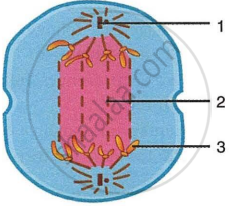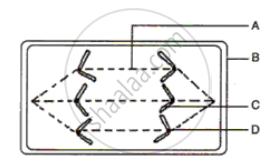Advertisements
Advertisements
प्रश्न
The diagram given below represents a stage in mitosis.

- Identify the stage given above.
- Give one reason to support your answer in (a).
- Mention the number of chromosomes given in the diagram.
उत्तर
- Anaphase
- Anaphase is characterised by the splitting of centromeres and the separation of chromatids, which move to opposite poles. This is readily obvious in the image provided. Hence, it is anaphase.
- The image contains eight chromosomes. The parent cell contained four chromosomes, which duplicated throughout the synthesis phase. During anaphase, they break and divide themselves evenly between the two daughter nuclei, resulting in each new cell having the same four chromosomes as the original.
APPEARS IN
संबंधित प्रश्न
The diagram below represents a stage during cell division. Study the same and then answer the questions that follow:

- Name the parts labelled 1, 2, and 3.
- Identify the above stage and give a reason to support your answer.
- Mention where in the body this type of cell division occurs.
- Name the stage prior to this stage and draw a diagram to represent the same.
Genetic recombination occurs in ______ phase of prophase of meiosis-I.
Fill in the blank:
______ takes place in body cells resulting in growth and development.
The diagram given alongside represents a stage in cell division.
Study the same and answer the questions that follow:

(i) Identify the stage of cell division.
(ii) Name the parts labeled A,B,C and D.
(iii) What is the unique feature observed in this stage?
(iv) Where does this type of cell division usually occur?
(v) How many daughter cells are formed from this type of cell division?
(vi) Is the dividing cell shown a plant or an animal cell?
Give a reason to support your answer.
Explain the Term Pachytene
Explain the Term Cell Diakinesis
Name the Following
The stage when chromosomes arrange at the equator.
Complete the following sentence with appropriate word :
______means the splitting of the nucleus.
The karyotype (set of chromosomes) shown below is taken from a dividing cell in a certain individual.
(i) Is the individual male or female? Explain your answer.
(ii) How would you expect
(a) a female cell and
(b) sperm cell to differ in chromosome composition?
In which stage of mitosis the chromosomes align in an equatorial plate? How?
